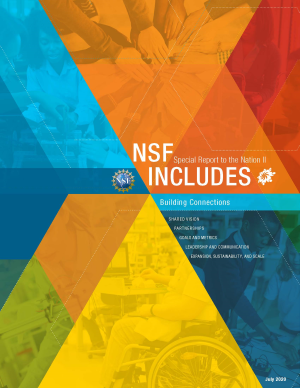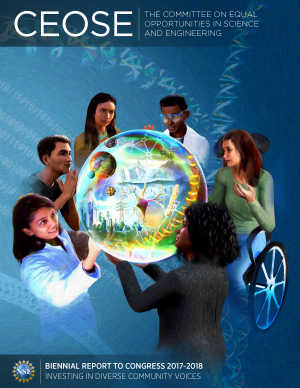Broader Impacts
The National Science Foundation increasingly has emphasized the need to justify not only the “intellectual merit” of proposed research, but also its “broader impacts” (Source). Broader Impacts refers to the potential of the proposed project to benefit society and contribute to the achievement of specific, desired societal outcomes.
Update on NSF Priorities (April 22, 2025) [Link] | “Can I still propose broadening participation activities (e.g., outreach) in fulfillment of the Broader Impacts criterion?”
Investigators should prioritize the first six broader impacts goals as defined by the America COMPETES Reauthorization Act of 2010. Investigators wishing to address goal seven — expanding participation in STEM for women and underrepresented groups — must ensure that all outreach, recruitment, or participatory activities in NSF projects are open and available to all Americans. Investigators may conduct these types of engagement activities to individuals, institutions, groups, or communities based on protected characteristics only as part of broad engagement activities.
Broader Impacts is a critical component of any research proposal submitted to NSF. Broader Impacts strengthen the relationship between the science community and society. When reviewing your proposal, NSF wants to know: How does your research impact society? NSF gives many examples of Broader Impacts (link); your approach to Broader Impacts (link) should consider all these possibilities, even if you have not previously done so.
- BI 1. Inclusion: increasing and including the participation of women, persons with disabilities and underrepresented minorities in STEM.
- BI 2. STEM workforce: developing a more diverse, globally competitive STEM workforce.
- BI 3. STEM education: improving education and educator development — at any level — in science, technology, engineering and mathematics.
- BI 4. Public engagement: increasing public scientific literacy and public engagement with STEM.
- BI 5. Societal well-being: improving the well-being of individuals in society.
- BI 6. Partnerships: building partnerships between academia, industry and others.
- BI 7. National security: improving national security.
- BI 8. Economic competitiveness: increasing the economic competitiveness of the U.S.
- BI 9. Infrastructure: enhancing infrastructure for research and education.
Broader Impacts is a critical component of any research proposal submitted to NSF. Reviewers will evaluate your Broader Impacts against these five criteria, outlined in the PAPPG (link):
- Criteria 1: what is the potential for the proposed activity to benefit society or advance desired societal outcomes?
- Criteria 2: to what extent do the proposed activities suggest and explore creative, original or potentially transformative concepts?
- Criteria 3: is the plan for carrying out the proposed activities well-reasoned, well-organized and based on sound rationale? Does the plan incorporate a mechanism to assess success?
- Criteria 4: how well qualified is the individual, team or institution to conduct the proposed activities?
- Criteria 5: are there adequate resources available to the principal investigator (either at the home institution or through collaborations) to carry out the proposed activities?
What is the difference between Broader Impacts and Broadening Participation?
While they are related, they are not the same thing. Broadening Participation is an important element which falls under Broader Impacts and aims to include individuals from underrepresented groups and institutions, thereby fostering collaboration among diverse social groups and leading to innovation. While Broadening Participation might be a key component of your Broader Impacts statement (especially if you include Broader Impacts focused on the BI 1 & 2, above), it’s not necessarily a required component. Also, it’s likely not the only societal impact of your project.
NSF is also interested in activities that broaden participation in STEM by:
- Developing a dynamic and highly qualified workforce, which is vital to maintaining the nation’s standard of excellence and global leadership in STEM.
- Supporting projects that inspire talent and create opportunities across all the nation’s communities, jurisdictions and territories.
- Using evidence-based approaches to build STEM education and research capacity, catalyze new areas of STEM research, and develop strategic partnerships and alliances.
NSF emphasizes four key areas in its Broadening Participation language (link):
- Strengthening discovery and innovation by providing leadership experience and advancement for faculty, staff and students while ensuring institutions have critical infrastructure to create new knowledge and innovations in STEM.
- Accelerating student success in STEM by supporting efforts that increase preK-12, undergraduate, graduate and postdoctoral success of individuals, institutions and communities interested in and committed to STEM disciplines and careers.
- Expanding the geography of innovation by supporting efforts to catalyze and nurture regional innovation clusters through investments in capacity building, partnerships, and research infrastructure.
- Conducting research on broadening participation in STEM to better understand individual and compounding factors that enhance or impede the nation’s ability to build a dynamic and highly qualified STEM workforce.


 The resources and tools on this site are designed to help Researchers and BI Professionals develop projects and partnerships that will satisfy the Broader Impact requirement of National Science Foundation (NSF) proposals, and help you fulfill your interest in communicating your science.
The resources and tools on this site are designed to help Researchers and BI Professionals develop projects and partnerships that will satisfy the Broader Impact requirement of National Science Foundation (NSF) proposals, and help you fulfill your interest in communicating your science.
